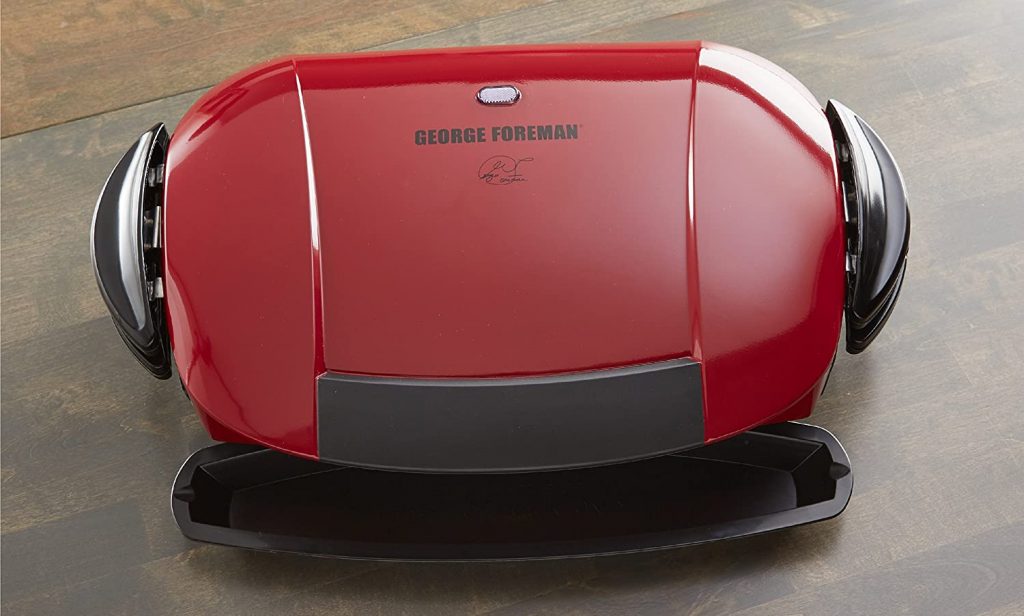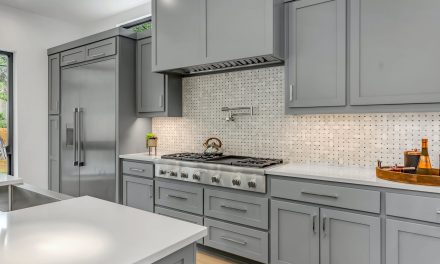Every summer, millions of Americans take advantage of the warm temperatures and longer days to grill outside. Barbecues and cookouts are staples of Memorial Day, Labor Day, and the Fourth of July. But what if it’s cold, rainy, windy, or you just don’t have the space for an outdoor grill? That’s where indoor grills come in.
Table of Contents
Types of indoor grills
From professional-grade built-in grills to countertop models and multipurpose cookers, there are tons of options for indoor grilling. But what kind of indoor grill will best suit your needs?
Stovetop grills
The simplest of all indoor grills, stovetop grills are simply large, grill-lined pans that sit over the burners on your stovetop. They’re a great option for the occasional indoor griller as well as for anyone who prioritizes versatility and customization. Many stovetop grills are reversible, with a griddle surface on the other side, and some are dishwasher safe. Choose between larger, multi-burner stovetop grills, like the Legend Cast Iron Griddle and smaller, more pan-like grills, like the Back Country Cast Iron Square Grill. Some may work best on gas stoves, but there are options for electric and conduction cooktops, as well. Stovetop grills come in cast iron and aluminum, as well as nonstick, varieties.
Pros:
- Requires nothing but a stovetop to use
- Has a similar temperature range to your stove
- Affordable
Cons:
- Grease trapped on the pan can prevent optimal grilling conditions
- Produces more smoke than other types
- May be harder to clean depending on composition
Price Range: $15-$300
Indoor/outdoor grill
Can’t choose between an indoor and an outdoor grill? Why not have both? With an indoor/outdoor grill, you can grill anywhere from your countertops to your balcony to your backyard. The George Foreman Indoor/Outdoor grill has a large, nonstick grill surface, adjustable temperature controls, and a removable stand to turn your outdoor experience into an indoor convenience.
Pros:
- Versatile—can use almost anywhere
- Tend to have larger cooking surfaces than countertop models
Cons:
- Take up a lot of counter space when cooking indoors
- The large grilling surface can make cleaning a hassle
Price Range: $70-$150
Countertop grills
Indoor countertop grills, sometimes called contact grills, come in a variety of styles. There are no official terms for the varieties, but they tend to fall in one of two camps: tray-type and catch-type. These terms loosely refer to the way the grill collects the fat that burns off meat. Some collect it in a separate tray that sits in front of a slightly slanted grill, while others collect it in a removable tray that’s beneath the grill.
Tray-type countertop grills

See George Foreman’s 5-serving indoor grill with its removable plates and drip tray.
Tray-type countertop grills are most similar to stovetop grills. A grill-lined pan is paired with a built-in heating element with the drip tray to the side of the cooking surface. WIth this type of countertop grill, flare-ups are nearly impossible as food drippings can never come in direct contact with the heating element. But draining is slower than in catch-type grills. Models like the George Foreman 5 Serving Grill and Panini Press boast a sloped, grill-lined pan and a removable drip tray, draining most grease away from your food as it cooks.
Pros:
- Flare-ups are extremely unlikely
- Most have lids that serve as additional cooking surfaces, allowing food to cook faster
Cons:
- Grease trapped on the pan can prevent optimal grilling conditions
- Can be more frustrating to clean
- Countertop grills tend to have fewer temperature settings
Price Range: $20-$120
Catch-type countertop grills
Catch-type countertop grills have grill grates very similar to a traditional outdoor barbecue grill, though they tend to include nonstick coatings. With this type of countertop grill, the drip tray and heating element are both underneath the cooking surface. Models like the Philips Smokeless Indoor Grill have dual infrared heaters and specially-designed heat reflectors to prevent hotspots, while at the same time the drip tray prevents flare-ups. Hamilton Beach’s Electric Indoor Searing Grill includes a viewing window in the lid and a special setting to ensure optimal searing.
Pros:
- Fairly easy to clean
- Grill grates allow grease to drain away instantly
Cons:
- Can produce more smoke
- Depending on design, may be more prone to flare-ups
- Countertop grills tend to have fewer temperature settings
Price Range: $30-$150
Multipurpose grills
If you want your countertop grill to do a bit more than just grilling, you’re in luck with a variety of multipurpose indoor grill options. Ninja’s indoor grills include air frying, dehydrating, roasting, and broiling capabilities. Cuisinart’s multifunction grill also slow cooks, bakes, sautées, steams, and griddles, while their Griddlers are combination grill/griddles that work as panini presses and even have waffle iron attachments.
Pros:
- Versatile
- Generally easy to use
Cons:
- Tend to be more expensive than single purpose electric grills
- May have more parts that need to be cleaned
Price Range: $40-$300
Built-in grills

Some Kenyon grills can be fit into both outdoor and indoor countertops.
A great option for the serious grill master, a built-in indoor grill provides unparalleled quality and versatility. You can do nearly everything you would on an outdoor grill, all from the comfort of your kitchen. In addition, a built-in grill is the only safe way to bring high-quality gas grilling indoors. Keep in mind, though, that a built-in indoor grill is a significant investment in both time and counter space.
Pros:
- Grill almost like you would outdoors
- Feature large cooking surfaces
- Grill grates tend to be removable and dishwasher safe
Cons:
- Some smoke flavors will still be inaccessible
- Require dedicated counter space
- Might require professional installation
- Tend to be pricey
Price Range: $750-$3,500
Don’t forget griddles
From the diner kitchen to the backyard grill to the home stovetop, griddles are a fast way to cook many different foods. While griddles lack the ridges of grills and so won’t be able to produce their characteristic grill marks, they’re still a great option for the aspiring indoor griller. Classic grilling favorites like steaks, burgers, chicken, and peppers cook well on griddles, and their flat cooking surface also allows wetter foods, such as eggs and pancakes, to be cooked right alongside. A griddle can’t provide the char marks characteristic of traditional grilling, but they can cook food quickly and efficiently. Try the Presto Electric Griddle for easy cleaning, easy cooking, and easy storage.
See Amazon’s bestselling electric griddles.
Pros:
- The lack of grill surface makes griddles easier to clean
- Cook everything from steaks to pancakes on the same cooking surface
Cons:
- Can’t produce distinctive grill marks
- These tend to be unitaskers
Price ranges significantly depending on the type of griddle and whether it’s built-in or not.
Is indoor griddling different from outdoor griddling?
Not really. Smoke is less of a concern on an outdoor grill/griddle, of course, and cleanup might be easier, but for the most part it doesn’t really matter where you use your griddle. Just keep it clean, watch your temperature, and get to griddling!
Pros and cons of indoor grilling
No longer is grilling relegated to the outdoor barbecue. Today, there are dozens of indoor grilling options for every setup, taste, and price point. And with more Americans living in apartments than ever before, indoor grilling is a great alternative! But how is indoor grilling different from outdoor grilling? Simply put, most of the differences are in the grill itself. Outdoor grills can use charcoal, propane, or natural gas. With indoor grills, you’re almost certainly cooking with electricity. Outdoor grills can have options for smoke boxes, allowing you to infuse more of those smoky flavors in your grilled foods. Indoor grills are designed to produce the least amount of smoke as possible. In addition, most outdoor grills can get way hotter than most indoor grills, so there are some things you just aren’t going to be able to do with an indoor grill. But that doesn’t mean you can’t make amazing food on your indoor grill. And some things will taste just the same.
Pros:
- Grill in all weather
- Perfect for apartment living
- Grill from the comfort of your kitchen
Cons:
- Indoor grills can be harder to clean
- You won’t have smoke options
- Indoor grills can’t match every flavor an outdoor grill can create
Are indoor grills actually smokeless?
Many indoor grills claim to be smokeless, and, while many models do include smoke prevention technology, the answer is a bit more complicated. While obviously indoor grills put off way less smoke than outdoor grills, not all the smoke generated through grilling comes from the coals, woodchips, or whatever else is in your outdoor grill. At higher temperatures (over 450°F/320°C) and in order to get the distinctive grill char, your meat might smoke. In fact, even at lower temperatures fatty meats may still smoke. The smoke point of most animal fats is around 375°F (190°C). The best way to ensure the most smoke-free indoor grilling experience possible is to keep an eye on your food at all times, trim away excess fat from meat, and purchase a model with the best smoke prevention technology.
Indoor grill safety
First of all, never grill indoors with an outdoor grill. Even in your garage. Large, open flames and the indoors don’t mix, and neither do low airflow and carbon monoxide. That being said, once you’ve set up your new indoor grill—how do you grill safely?
- Ventilation
- Indoor grills generally do a good job keeping smoke to a minimum, but they’re not perfect. For best results, run your stove fan or crack a window.
- Keep it clean
- Smoke and flare-ups are often caused by grease build up. Make sure to clean the grill surface, drip trays, and any other parts of the grill that may come in contact with heat before grilling.
- Prepare your food
- Trim fat from meat. Excess fat causes most of the smoke in indoor grilling. Trim off as much as possible from your meat before grilling.
- Pat meats dry before cooking.
- Drain off oily marinades before cooking.
- Avoid dry rubs with large pieces of herbs that may burn.
- Keep an eye on it
- A good idea whether you’re indoors or outdoors, it’s especially important to not walk away from your indoor grill while you’re grilling.
- Have a fire extinguisher in your kitchen
- Always a good idea, no matter what you’re cooking!
Cooking with indoor grills
With the right grill and an arsenal of cooking options, the world of grilling is yours from the comfort of your kitchen!










